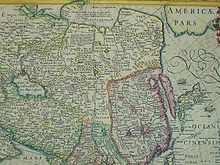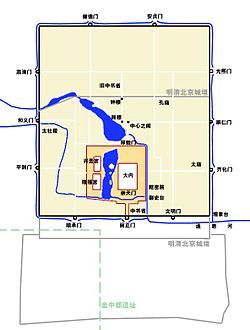- Khanbaliq
-
For other uses, see Dadu (disambiguation).
Khanbaliq or Dadu refers to a city which is now Beijing, the current capital of the People's Republic of China. The city was called Dadu or Tatu (大都, pinyin: Dàdū, Wade-Giles: Ta-tu), meaning "great capital" or "grand capital" in Chinese, the name for the capital of the Yuan Dynasty founded by Kublai Khan in China, and was called Daidu by the Mongols,[1] which was a transliteration directly from the Chinese.[2] It is known as Khanbaliq (汗八里),[3] also spelled as Khanbalikh[4] in Turkic languages, meaning "Great residence of the Khan", and Marco Polo wrote of it as Cambaluc, Cambuluc, or Kanbalu.
Contents
History
Under the name Zhongdu (中都, "central capital", pinyin: Zhōngdū) the city had earlier served as the capital of the Jin Dynasty, but was burned down in 1215 by Mongol forces. In 1264, in preparation to establish the Yuan Dynasty, Kublai Khan decided to rebuild this city as his new capital. The original architect and planner of the capital was Liu Bingzhong,[5] who also served as the supervisor of its construction,[6] and one of the main people who designed and led the construction was Yeheidie'erding (Amir al-Din).[7] The construction of the walls of the city began in the same year, while the imperial palace was built from 1274 onwards. The design of Dadu followed the Confucianism classic Zhouli (周禮, "rites of Zhou"), in that the rules of “9 vertical axes, 9 horizontal axes”, “palaces in the front, markets in the rear”, “left ancestral worship, right god worship” were taken into consideration. It was broad in scale, strict in planning and execution, complete in equipment.[8]
After the establishment of the Yuan Dynasty in 1271, Kublai Khan renamed the city to Dadu (大都, "great capital", or Ta-tu in Wade-Giles) in 1272,[9] and it officially became the capital of the Yuan Dynasty, though some constructions in the city were not completed until 1293. The previous seat of Kublai Khan, Shangdu, became the summer capital of the Yuan. During the reign of Kublai Khan, Venetian merchant Marco Polo arrived at Dadu and Shangdu, where it is said that he served Kublai Khan for seventeen years.
In 1368, Zhu Yuanzhang, soon after declaring himself the first emperor of the Ming Dynasty in Nanjing, sent an army toward Dadu, still held by the Yuan. The last Yuan emperor fled north to Shangdu, and Zhu Yuanzhang razed the Yuan palaces in Dadu to the ground.[10]
Aftermath
 While Khanbaliq was known to European geographers, its exact location - or its identity with Beijing - was not quite clear. This map from 1610 repeats a fairly common pattern for the period: it shows two Khanbaliqs (Combalich in the land of Kitaisk on the Ob River, and Cambalu, in Cataia north of the Great Wall) and one Beijing (Paquin, at its correct location in Xuntien (Shuntian) prefecture).
While Khanbaliq was known to European geographers, its exact location - or its identity with Beijing - was not quite clear. This map from 1610 repeats a fairly common pattern for the period: it shows two Khanbaliqs (Combalich in the land of Kitaisk on the Ob River, and Cambalu, in Cataia north of the Great Wall) and one Beijing (Paquin, at its correct location in Xuntien (Shuntian) prefecture).
After the fall of the Yuan Dynasty in 1368, the city was renamed Beiping (北平, pinyin: Běipíng) by the Ming Dynasty in the same year,[11] and Shuntian (順天) prefecture was established in the area around the city. After the enthronement of Yongle Emperor of Ming, he extended the city and commissioned the building of the Forbidden City within the walls of the Imperial city of Yuan's Dadu. He renamed the city to Beijing (北京, pinyin: Běijīng, ‘Peking’, or Pekin in obsolete romanizations), which continues to the present day - except for a short time in Republican China where it was again known as Beiping. Remains of parts of the ancient walls of Dadu, which lie slightly to the north of the later Ming Dynasty walls, are still extant in modern-day Beijing and are known as the Tucheng (土城, literally, the 'earth wall').[12]
Later history of the name
Despite the change of the name of the city in Chinese, the name "Khanbaliq" remained in use among Mongols for centuries after the fall of the Yuan Dynasty.[citation needed] Tayisung Khan Toghtoa Bukha's Taishi Esen appealed to Mongol nobles, saying "...Let's take back our Khanbaliq" before his invasion of China.[13][dubious ] It was picked from them by Russians, whose 17th-century documents often referred to Beijing as "Kambalyk" (Камбалык), as it appears e.g. in the account of Fyodor Baykov's embassy to Beijing in the 1650s.[14]
When in the 16th century the Western Europeans reached China via Malacca and South China, they were not initially aware that China is the same country as "Cathay" about which they had known from Marco Polo, or that the "Cambalu" of Marco Polo's fame is Beijing. It was not until Matteo Ricci's first visit in Beijing (1598), and his meetings with Central Asian visitors ("Arabian Turks, or Mohammedans", in Louis J. Gallagher's translation) who told him that the city they are in is "Cambalu", that he became fully convinced that Cathay was China and Cambalu was Beijing. The learned Jesuit even folk-etymologized the name "Cambalu" as being "partly of Chinese and partly of Tartar origin". According to Ricci's fanciful etymology, "Cam" (Khan?) meant "great" in "Tartar language", "Ba" came from Chinese bei (北), "north", and "Lu" was the usual way of referring to the "Tartars" in Chinese books.[15] Despite Jesuits' reports about the identity of Cathay and China, and Cambalu and Beijing, many European maps continued to show "Cathay", with its capital "Cambalu", located somewhere northeast of China proper, for much of the 17th century.
References
- ^ Rossabi, Morris, Khubilai Khan: His Life and Times, p 131
- ^ Herbert Franke, John K. Fairbank (1994). Cambridge: Cambridge University Press. p. 454.
- ^ George Lane, Genghis Khan and Mongol Rule, p 198
- ^ Stephen G. Haw, Marco Polo's China, p61
- ^ China archaeology and art digest, Volume 4. Art Text (HK) Ltd. original from the University of California. 2001 (digitized 2009). http://books.google.com/books?id=4_MUAQAAIAAJ&dq=editions%3Az_AUAQAAIAAJ&q=Liu+Bingzhong#search_anchor.
- ^ Stephen G. Haw (2006). Marco Polo's China: a Venetian in the realm of Khubilai Khan. Psychology Press. p. 69. ISBN 0415348501. "Liu Bingzhong was also charged with overseeing the construction of the Great Khan's other new capital, the city of Dadu."
- ^ People's Daily Online: The Hui ethnic minority
- ^ 《明史纪事本末》、《纲鉴易知录》卷八
- ^ The New Encyclopædia Britannica (Encyclopædia Britannica, Chicago University of, William Benton, Encyclopædia Britannica), p 2
- ^ Ebrey, Patricia Buckley. The Cambridge Illustrated History of China. Cambridge: Cambridge University Press, 1999. ISBN=0-521-66991-X
- ^ Susan Naquin, Peking: Temples and City Life, 1400-1900, p xxxiii
- ^ Beijing This Month - Walk the Ancient Dadu City Wall
- ^ Ming shi, pp.328
- ^ "Выписка, составленная в Посольском приказе, о путях в Цинскую империю [Report about the routes from Russia to the Qing Empire, compiled by Russia's Foreign Office]" (in Russian). 1674, no earlier than July 17. http://ostrog.ucoz.ru/ist_doc_3/1_114.htm. (Russian)
- ^ Trigault, Nicolas S. J. "China in the Sixteenth Century: The Journals of Mathew Ricci: 1583-1610". English translation by Louis J. Gallagher, S.J. (New York: Random House, Inc. 1953) of the Latin work, De Christiana expeditione apud Sinas based on Matteo Ricci's journals completed by Nicolas Trigault. Book four, Chapter 3, "Failure at Pekin", pp. 312-313. There is also full Latin text available on Google Books.
Categories:- Ancient Chinese capitals
- 1264 establishments
- History of Beijing
- Yuan Dynasty
Wikimedia Foundation. 2010.

